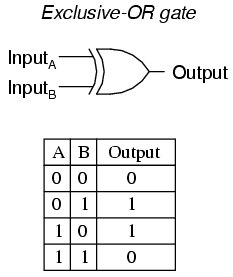Not sure if this has been looked upon before but I would like it to be implemented so I can build other logic circuits with it.
For those of you who don't know, the XOR Gate (exclusive-or) is a gate that functions like an OR gate, except it works a bit differently.
Just like an OR gate, the output is low when all inputs are low and if at least one input is a high the output is high. However when all inputs are high, the output is low. A truth table with a two input XOR Gate is shown below.

I've made this logic gate already using AND gates and OR gates, but I have to use four or five gates just to make the logic function.
With it I believe we can expand our understanding of logic even more. I would like to see if this be added to logic if it could. I appreciate any thoughts you have.
For those of you who don't know, the XOR Gate (exclusive-or) is a gate that functions like an OR gate, except it works a bit differently.
Just like an OR gate, the output is low when all inputs are low and if at least one input is a high the output is high. However when all inputs are high, the output is low. A truth table with a two input XOR Gate is shown below.

I've made this logic gate already using AND gates and OR gates, but I have to use four or five gates just to make the logic function.
With it I believe we can expand our understanding of logic even more. I would like to see if this be added to logic if it could. I appreciate any thoughts you have.
